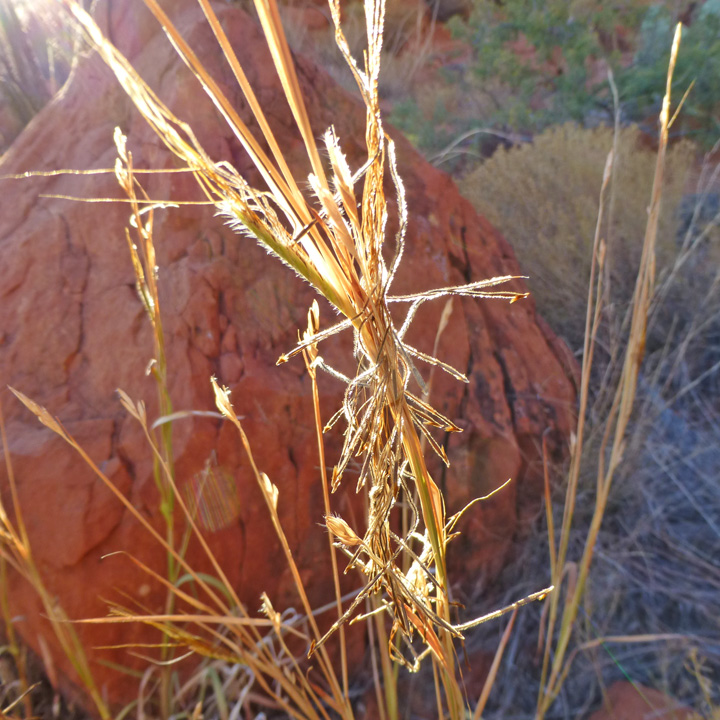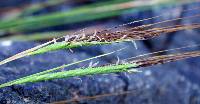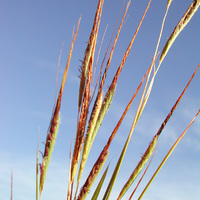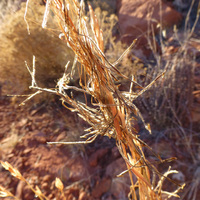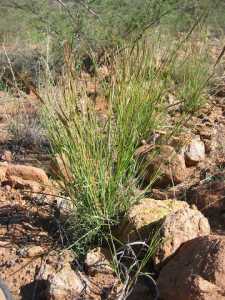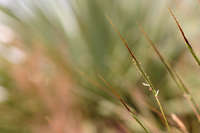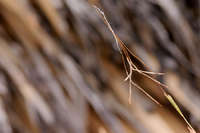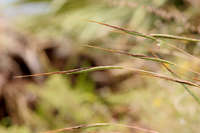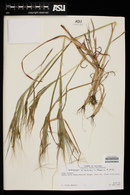|
Family: Poaceae
tanglehead
[ Andropogon contortus L., moreAndropogon secundus Griseb.] |
Plants perennial. Culms 20-150 cm, erect. Sheaths
smooth, reddish; ligules 0.5-0.8 mm, cilia 0.2-0.5 mm; blades
10-15 cm long, 2-7 mm wide, flat or folded, glabrous or pubescent. Rames
3-7 cm, secund, with 12-22, brown to reddish-brown, sessile-pedicellate spikelet
pairs. Homogamous spikelets 6-10 mm. Heterogamous spikelets: sessile
spikelets 5-10 mm, brown, awned; calluses 1.8-2 mm, strigose; awns
6-10 cm; pedicellate spikelets 6-10 mm, unawned; glumes ovate-lanceolate,
glabrous or with papillose-based hairs distally, without glandular pits, greenish
to purplish-brown, becoming stramineous when dry. 2n = 40, 50, 60. Heteropogon contortus is a valuable forage grass if continuously
grazed so as to prevent the calluses from developing. It is also considered
a weed, being able to establish itself in newly disturbed and poor soils.
FNA 2007, Gould 1980, Kearney and Peebles 1969 Common Name: tanglehead Duration: Perennial Nativity: Native Lifeform: Graminoid General: Small, tufted perennial grass; culms erect, 20-150 cm tall, usually branching well above the base. Vegetative: Sheaths smooth, reddish, compressed-keeled, mostly glabrous, with few long hairs at junction with blade; ligules <1 mm, truncate, membranaceous, brown, and fringed with white hairs; blades 10-15 cm long, 2-7 mm wide, folded or occasionally flat, glabrous Inflorescence: Rames 3-7 cm long, with 12-22, brown to reddish-brown, sessile-pedicellate spikelet pairs. The lowest few pairs of spikelets homogamous, unawned, 6-10 mm. Distal spikelet pairs heterogamous, with long-awned sessile spikelets, 5-10 mm, brown, the awns 6-10 cm, calluses 2 mm, strigose; pedicellate spikelets of the heterogamous pairs unawned, 6-10 mm; glumes ovate-lanceolate, glabrous or with papillose-based hairs distally, greenish to purplish-brown, becoming stramineous when dry. Disarticulation in the rames, beneath the sessile spikelets of the heterogamous pairs, sometimes also below their pedicellate spikelets. Ecology: Found in open, dry, rocky and sandy plains and slopes, from 1,000-5,500 ft (305-1676 m); flowers August to October, and occasionally in the springtime also. Distribution: s CA, AZ. s NM, s TX; south to s through MEX to S America and much of the Old World. Notes: A distinct perennial grass to 1.5 m, distinguished by the single-seeded spikelets with long, twisted, dark brown awns, which often fall entangled with the awns of other spikelets; also look for the large green-brown glumes subtending each spikelet which hug the inflorescence spike. A valuable forage grass. Ethnobotany: Unknown Etymology: Heteropogon is from Greek for differently or variously bearded, alluding to the difference between the awnless-homogamous spikelets and the awned-heterogamous spikelets; contortus means twisted, referring to the long, twisted awns. Synonyms: Andropogon contortus Editor: SBuckley 2010, FSCoburn 2014, AHazelton 2015 |

